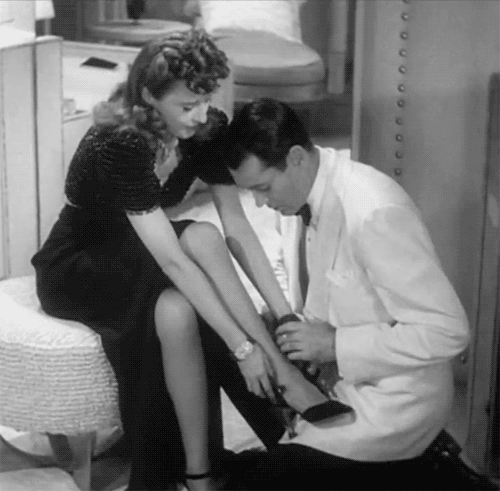Howard Hawks is a great example of a director who was rescued by film critics.
SARRIS: Well, by the French!
Could you talk about how that happened? Hawks was successful as a director in Hollywood, but not really known.
SARRIS: He was successful, but he wasn’t prestigious.
HASKELL: Wasn’t taken seriously.
SARRIS: I think he was only nominated for one Oscar, for Sergeant York. And he never won an Oscar, of course. The first time I heard about him was when my friend Eugene Archer, went to Paris in the 1950s on a Fulbright. He wrote me a letter and said, “Who the hell is Howard Hawks?” He had signed a contract for a book that he was going to do about six directors: Elia Kazan, John Ford, George Stevens, and so on. The Cahiers people said, “Ugh! What about Howard Hawks and Hitchcock?”
And so he wrote me this letter; it’s the first time I heard anybody being so high on Hawks. I had seen a lot of Hawks’s movies in revival houses, so I was really up on him. But I couldn’t quite get him, because he had so many different genres. And that’s what the French loved about him, precisely. Because for instance, Hitchcock would never do a western or a musical. And then Dan Talbot ran a Hawks festival at the New Yorker Theater, and I wrote something about it. And I was writing for little publications.
And you were reading the French critics on Hawks?
SARRIS: Yeah, in Cahiers. Truffaut and Godard were just crazy about Hawks. And especially at that time, Rio Bravo had just come out, and that was, to them, huge. And here, people just thought it was another western.
And another thing, it was sort of an accident of film history. Robert Warshow wrote “The Gangster as Tragic Hero,” and he wrote about Little Caesar and The Public Enemy but he didn’t write about Scarface, because Scarface was not in general circulation for many years. It was a Howard Hawks picture, and the French had been on Scarface’s trail since ’32. So it was not just the Cahiers people. Even before Cahiers, Hawks was admired for Scarface. And all the other 1930s adventure films. But here in America, even Warshow didn’t know about Scarface. In fact, I hadn’t seen it when I was writing all these Hawks articles; it still wasn’t available. I only saw it very much later.
Million Dollar Movie
Million Dollar Movie
Jeanine Basinger in the New York Review of Books:
Ava Gardner and Barbara Stanwyck were separated by fifteen years in age, and arrived in Hollywood more than a decade apart. Although both were famous stars, neither ever won a competitive Academy Award. (Gardner was nominated once for Mogambo and Stanwyck four times, for Stella Dallas, Ball of Fire, Double Indemnity, and Sorry, Wrong Number. She received an honorary Oscar in 1982 for her “unique contribution to the art of screen acting.”) Both were at the top during the golden age of the Hollywood studio system, but one difference between them is fundamental: Ava Gardner was a product of the “star machine” and Barbara Stanwyck was not.
Gardner, from a not very well off but stable North Carolina family, arrived in town with a minimum of security and no acting experience, but was fed into a system that might be expected to take care of her if she behaved. Stanwyck, coming from a hardscrabble background in New York, arrived from Broadway with the security of a contract and solid experience, but took up her career independently and never let anyone own her.
Gardner’s security came with a price. Unable to pick and choose, she was assigned pedestrian films she had to carry (The Great Sinner in 1949, My Forbidden Past in 1951). She wasn’t given many opportunities to grow as an actress. The studio didn’t need that from her, and because of her spectacular looks, she presented something of a casting problem. Who would believe Ava Gardner as a nun, or a rocket scientist, or a neglected working girl in a tuna cannery? She was born to grab the spotlight, and having shaped her image as “a magnificent animal” (her billing for The Barefoot Contessa, 1954), Hollywood was content to present her that way.
Gardner became resentful and restless, and began to carouse, have affairs, and create problems. She didn’t care if she caused a scandal, particularly when she took up with the married Frank Sinatra and became the most famous “other woman” of her time. Ironically, it was easy for her studio to fuse this off-screen behavior to her on-screen persona, and the role of “Ava Gardner,” bad-girl-good-time-gal-sex-symbol, became an unbreakable image.
Stanwyck’s independence meant that she could negotiate her films and salaries, but she had to accept that she had no priority in any studio’s plans for casting. She lost significant roles as a result, such as the lead in Dark Victory (1939), which went to Bette Davis. Wilson points out that a studio “would have steadily built her up picture after picture,” as MGM did with Gardner, but Stanwyck didn’t want that: “She found it a constraint.” Stanwyck had to fight to get good films, but she had her own supporters, including her first husband, Frank Fay (an established born-in-a-trunk performer), a shrewd agent, Zeppo Marx (the fifth Marx brother), and particularly director Frank Capra, who saw what she was capable of and who guided her in four of her earliest films. As curator of the Frank Capra Archives, I spent many hours talking to Capra about his career, and Stanwyck was a subject he loved. A great admirer of her talent, discipline, and professionalism, he always stressed that since Stanwyck was never owned by a single studio for any length of time, no specific image was created for her. She had to create her own.
The Rise and Fall of Penn Station
Tonight on “American Experience” gives Penn Station.
Million Dollar Movie
I didn’t buy The Fighter much as a boxing movie and I had a hard time believing some of the characters and scenarios in Silver Lining Playbook but I also enjoyed both movies. Sometimes you aren’t irritated by things that would normally bug the hell out of you. That’s the only way I can figure it–it’s a matter of taste.
Almost everything in first few minutes of American Hustle–a protracted take of Christian Bale gluing fake hair to his head, a slow motion montage set to classic rock music, showy period decor and outfits not to mention everybody’s hair, oh, that hair!–would usually annoy me. But in this case, it didn’t. In these first minutes the mix tape is rolling–from the movie’s signature tune, Duke Ellington’s 1958 recording of “Jeep’s Blues”, to America’s “A Horse with No Name’, to “Dirty Work,” the moody and vibe Steely Dan record. The two rock songs are as obvious (“On the first part of the journey…”) as the hairstyles but they made me happy regardless.
Christian Bale hides underneath an elaborate combover and a big gut. He fidgets with his glasses and at times seems to a pastiche of mannerisms from other actors (Alec Baldwin’s cackle, Robert De Niro’s body language). It’s hard not to be aware of his acting and yet I found this to be the most sympathetic performance. He deadpans his way through many of his scenes and he’s easy to root for. So is Bradley Cooper who plays his nemesis, a slick, ambitious climber, whose sadism in a few scenes suggest Peter Seller’s Claire Quilty. (He’s also funny, like when he does a quick impersonation of his boss–played by an effective Louis C.K.)
Amy Adams is terrific as Bale’s partner and Jennifer Lawrence continues to brighten any movie in which she appears even though her role is small and underwritten (she can’t quite seem to decide on an accent but otherwise gives her part great credibility). The showdown scene between Adams and Lawrence is not something I’ll soon forget. Russell likes women and he takes care to treat them with respect. In one crucial scene, Adams gives an pointed speech and leaves Bale with something to think about. The scene ends with her walking out of the room. As she walks away her full body comes into frame. I waited for Russell to show her ass–the wiggle, to punctuate things–but he cuts just before the wiggle. A subtle choice.
Jeremy Renner ( more good hair) is strong in a supporting role and Robert De Niro is frightening in a cameo. It’s been a long time since I recall being moved by De Niro but I thought he was really good.
American Hustle is a feast of over-the-top moviemaking (anxious, luxuriant). You can’t get away from the movieness of it. The comparisons to Good Fellas might be superficial but they aren’t far-fetched. This isn’t just a 70’s nostalgia movie like Carlito’s Way, or The People vs. Larry Flynt or Candelabra, it belongs to a specific sub-genre that began with Good Fellas and continued with Boogie Nights and Blow. The technique is familiar. Russell’s camera is constantly moving, pushing in, tracking, panning. I’ve read that Russell likes to be in close proximity to his actors, often calling out lines to them as they improvise a scene. The camera is never far away from them, either. You can almost feel Russell in the scene with them. I like how they recorded the voice overs, especially here–there is a breathiness to it that heightens the sense of intimacy.
Much of Russell’s style comes from Scorsese. But if Russell grew up on Casavettes and Altman and Scorsese he’s closer to Preston Struges. His for screwball comedy, especially between men and women, is his most winning trait. For all the yelling and screaming that goes on in his movies, things turn out okay for everyone in Russell’s world. There isn’t one sequence that has the kind of nervy tension of the Alfred Molina scene in Boogie Nights. Russell never makes you that uneasy. For some people, this is where he falls down. I’ve talked to a lot of people who think American Hustle is phony. And I can see that. But I respond to the pleasures he offers up. They win out.
New York Minute
It’s less than 24 hours since police found Phillip Seymour Hoffman dead in his apartment. The description of how he was found is graphic and since we know him so well from the movies it’s easy to picture it all in painful detail.
It’s a blue Monday in New York.
[Photo Credit: Jonathan Smith]
Million Dollar Movie
A few brief highlights from the late Phillip Seymour Hoffman:
[Photo Credit: Desmond Muckian]
Crimes and Misdemeanors
Here is a well-informed and balanced take on the lingering scandal between Woody Allen, his ex girlfriend Mia Farrow, their children, his wife, and allegations of sexual abuse.
Million Dollar Movie
“We’re in a business where people perceive complexity as good. It’s not good. Complexity is not good. People don’t understand the elegance of simplicity. There are very few people left that do understand it. The whole idea is take a sophisticated idea and reduce it to the simplest possible terms so that it’s accessible to everybody — and don’t get simple mixed up with simplistic. It’s how you mount and present something that makes it engaging…Simplistic is doing it badly…simple is your choices.”
Gordon Willis on cinematography.
Million Dollar Movie
In this weekend’s book review, Molly Haskel reviews the massive first volume of Victoria Wilson’s new Barbara Stanwyck biography:
Start with the voice, which seems to have been around since the world began: lush, weary, tender, worldly, skeptical, ranging nimbly between hard and soft. It could be metallic, mannish and brittle or gentle as a down pillow, sometimes within the same film, as befits an actress who was at ease in every genre, from woman’s melodrama to the western, with noir and screwball comedy in between. Though film buffs have treasured her for years, Barbara Stanwyck has burned less brightly among general moviegoers for whom a higher voltage is synonymous with stardom.
She was neither a great beauty nor a glamour puss, and the importance of this — her refusal or inability to be simplified into a single image — has to be seen as a major factor in her longevity. More iconoclast than icon, more a character star on the order of Bogie or Cagney, she was often the second or third choice after Claudette Colbert, Jean Arthur, Bette Davis and Irene Dunne. Yet she has worn especially well. And if she was underappreciated in her time, her minimalist gifts — the fluid movement, the stillness in repose, the sense of interiority — have come to seem ultramodern.
If ever there was an actress who was ready for prime time, it is Stanwyck, and this enormously informative tribute — juicy yet dignified, admiring yet detached — is the book to bring her to center stage. Or books, I should say, for this full-dress treatment is not for the fainthearted: “A Life of Barbara Stanwyck: Steel-True 1907-1940,” at 860 pages of text (notes, index and appendices bring it to 1,044), is only the first volume, beginning with Stanwyck’s birth and ending with the films preceding World War II. Wilson stays resolutely and sometimes frustratingly within this time frame, resisting even an anticipatory peek at those glorious ’40s films. I confess to having felt a certain alarm when I heard that Wilson, a vice president and longtime editor at Knopf whose first book this is, was writing two volumes on Stanwyck. In general, only someone of global consequence merits such exhaustive and demanding length. It seemed — and still seems — especially disproportionate in the case of Stanwyck, whose talent for passing under the radar was one of her charms. But Wilson’s aims are far more ambitious than documenting the minutiae of a movie star’s life.
What she does is provide context of extraordinary breadth, taking in not only Stanwyck’s life, her beginnings in poverty and tragedy and her emergence as an emblem of self-sufficiency, but also the world through which she moved: the cultural and political forces that shaped her years in show business as she went from burlesque and theater in New York to the turbulent Hollywood of the 1930s. Each film from this period is recounted in detail — indeed not just the films she made, but the ones she almost made and the parts she didn’t get. These descriptions are interspersed with mini-biographies of the various participants, forays into Stanwyck’s social life (or antisocial life, as the case often was), along with politics, both local and national.
Margaret Talbot picks some of Stanwyck’s finest work over at the New Yorker.
--Earl Weaver























